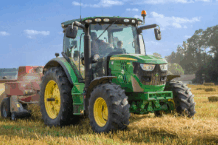Kansas wildlife officials have an idea for how to stop an invasive fish known for its jumping ability from leaping over a Lawrence dam and swimming upstream toward Topeka, further infesting the Kansas River.
This fish can jump. Social media has several videos, like one earlier this month that went viral on TikTok showing a carp jumping into a boat in Kentucky, hitting children.
Those invasive carp are also in Kansas, where their jumping ability enables them to pass dams, especially during floods. To prevent them from infesting more waterways, like the Kansas River around Topeka, experts are turning to a simple solution: grates.
Chris Steffen is the aquatic invasive species coordinator at the Emporia office of the Kansas Department of Wildlife and Parks. He gave the Wildlife and Parks Commission an update on invasive carp at a meeting last month.
Two carp species in particular, bighead and silver, have made it to the Kansas River. Those species are among the fish referred to as invasive carp that used to be referred to as Asian carp.
“The silver carp is the one you’ll see on YouTube or other places where people are riding around on skis or whatever behind a boat, and these carp are jumping,” Steffen said. “They’re able to jump up to maybe 10 feet in the air when spooked by a boat.”
The fish are filter feeders.
“They open their mouth, they swim around with their mouth open and eat all the small stuff in the water,” Steffen said. “The plankton, the zooplankton, phytoplankton. Surprisingly long lived, and they can grow to really incredible sizes, and they’re also capable of these really large, quick movements. Typically those are during high flow events.”
Native fish populations have declined in areas where invasive carp have moved in.
The Kansas River is infested with invasive carp between Lawrence and the Missouri River. Also infested are the Missouri River in northeast Kansas and part of the Neosho River in Labette County in southeast Kansas.
“Everything that doesn’t have a dam that’s attached to the Missouri River basin has these silver and bighead carp,” Steffen said.
But having a dam isn’t enough, as high water events have allowed the jumping carp to pass the barrier. That was the case with flooding in 1993, after which isolated fish were collected farther upstream from Lawrence, around Manhattan and Junction City.
Upstream 15 miles from the Missouri River is the WaterOne Dam in Wyandotte County, just east of the Interstate 435 Bridge.
“The carp, most of the time, cannot get over this barrier,” Steffen said.
However, Steffen referred to that dam as “semi-passable” because the fish can get over the barrier during high water events — which have happened occasionally in recent years.
Farther up the river is the Bowersock Dam in Lawrence — the only hydropower facility in the state.
Steffen called it “a much more formidable barrier to carp movement.”
Still, the carp can get past it during especially high water events, like in 1993, and KDWP has concerns about the dam’s north powerhouse. Installing bars, referred to as a headbanger, are a simple and low-tech solution.
“It’s just basically grates that hang out over the water that when those carp try to jump up into that structure, they literally just bounce off that grate,” Steffen said. “It’s really slick. It’s kind of self-cleaning. It’s got an angle to it, so any debris that comes in there just kind of pushes off the side.”
As of the Aug. 29 meeting, KDWP had already completed a structural analysis but was waiting on grant funds before getting to work on engineering and installation.
Invasive carp were the subject of a rebranding campaign intended to increase human consumption.
They’re also good bait for catfish, Steffen said.
Meanwhile, the infested 15-mile section of the river east of the WaterOne Dam is popular for fishing, according to a 2022 KDWP angler survey. That has the agency looking at a snagging opportunity.
Wildlife and Parks staff are proposing year-round snagging — but with harvest limited to only carp, and other fish would have to be released — in the Kansas River downstream from the WaterOne Dam. Steffen said carp are overly abundant there, but snagging them is technically illegal for now.
“Because they would be helping us out getting rid of carp that we don’t want in the river there, we’re not proposing any sort of special permit,” Steffen said. “This would be allowed on your standard fishing license.”
There’d be no possession limit, because, “The more carp we can get out, the better.”
Meanwhile, KDWP is going to use grant funding from the U.S. Fish and Wildlife Service to work on removing carp from the area between the WaterOne Dam at Edwardsville and the Bowersock Dam at Lawrence.
As reported in the Topeka Capital Journal



